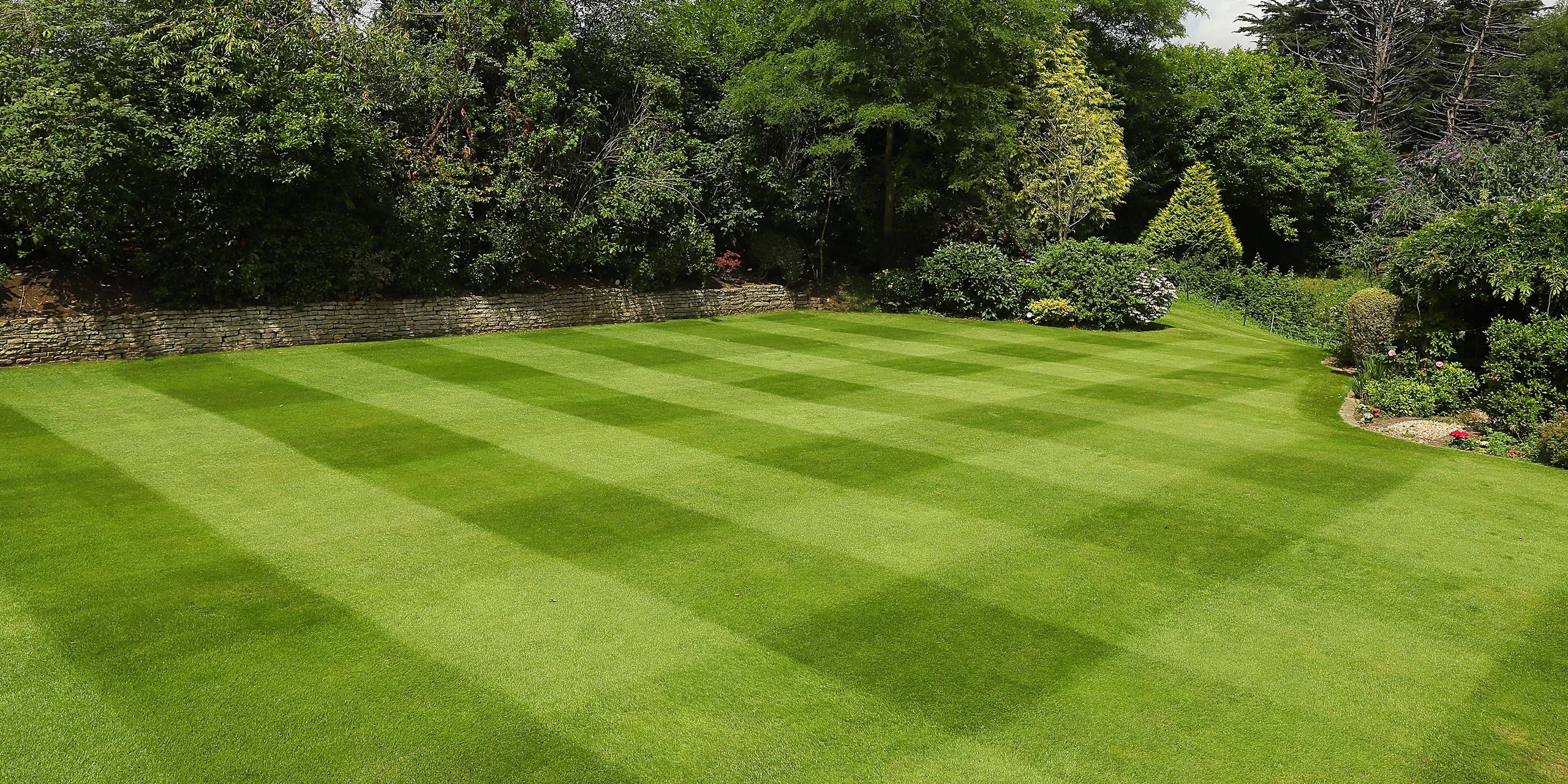January Lawncare Tips
- We hope you all had an enjoyable Christmas and new year. With the festivities over, and minimal work required on the lawns, now is the time to plan your yearly maintenance and feeding regimes. January marks the low season for lawns in the UK characterised by cold temperatures and shorter daylight hours that result in minimal growth. Consequently, the need for frequent lawn mowing diminishes. However, it's essential to consider appropriate maintenance or lawn treatments during this period.
- If there is any frost about, the advice is to keep off the grass; you can bruise the plant and leave unsightly black footprints which can turn brown as the grass leaf dies.
- If it looks like it is going to snow (it’s January after all), and you are concerned that the snow will affect the lawn, then Turf Hardeners or iron based fertilisers can be used to ‘toughen’ the grass and keep any fungal diseases such as Snow Mold at bay.
- Leaf and debris collection should continue when conditions allow. If leaf litter is left, it will stop the light from getting to the grass underneath, and as the nights have drawn in, the grass will need all the light it can get. If you are going to mow your lawn make sure conditions aren't too wet and make sure you are mowing at a high height of cut. DO NOT MOW if there are frosts due. January is a good time to aerate your lawn. Aeration can help with drainage and with loosening compact ground. This all contributes to the health of your grass over winter.
- As part of your maintenance plan, make sure your mower and other mechanical equipment are taken into account. At the very least, wash down and grease or oil the working parts. If it’s a petrol mower, please remove any remaining petrol as this can go stale and may prevent the mower from starting when you come to use it. Book the mower in for a service, and have the blades sharpened, if it’s a while since you’ve had this done. The good news is that nights are getting lighter by the day! Spring will soon be here!
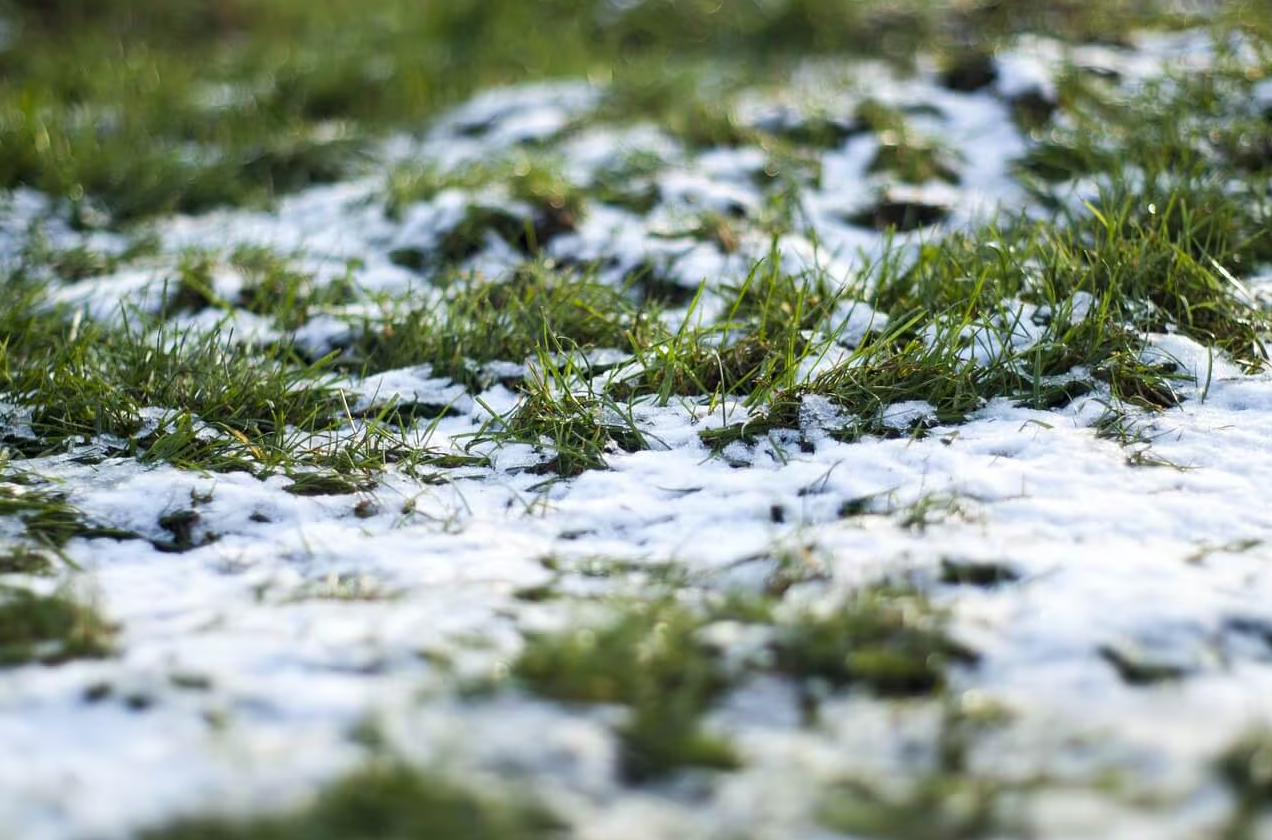
January Lawncare Tips
- We hope you all had an enjoyable Christmas and new year. With the festivities over, and minimal work required on the lawns, now is the time to plan your yearly maintenance and feeding regimes. January marks the low season for lawns in the UK characterised by cold temperatures and shorter daylight hours that result in minimal growth. Consequently, the need for frequent lawn mowing diminishes. However, it's essential to consider appropriate maintenance or lawn treatments during this period.
- If there is any frost about, the advice is to keep off the grass; you can bruise the plant and leave unsightly black footprints which can turn brown as the grass leaf dies.
- If it looks like it is going to snow (it’s January after all), and you are concerned that the snow will affect the lawn, then Turf Hardeners or iron based fertilisers can be used to ‘toughen’ the grass and keep any fungal diseases such as Snow Mold at bay.
- Leaf and debris collection should continue when conditions allow. If leaf litter is left, it will stop the light from getting to the grass underneath, and as the nights have drawn in, the grass will need all the light it can get. If you are going to mow your lawn make sure conditions aren't too wet and make sure you are mowing at a high height of cut. DO NOT MOW if there are frosts due. January is a good time to aerate your lawn. Aeration can help with drainage and with loosening compact ground. This all contributes to the health of your grass over winter.
- As part of your maintenance plan, make sure your mower and other mechanical equipment are taken into account. At the very least, wash down and grease or oil the working parts. If it’s a petrol mower, please remove any remaining petrol as this can go stale and may prevent the mower from starting when you come to use it. Book the mower in for a service, and have the blades sharpened, if it’s a while since you’ve had this done. The good news is that nights are getting lighter by the day! Spring will soon be here!

February Lawncare Tips
- We’ve had a mixture of weather in January with frosts, snow and milder wetter weather but nights are starting to get lighter. As with any frosts, those with fine lawns should wait until the frost has lifted before going on. You can bruise the grass, leaving unsightly black footprints in the lawn which can turn brown as the grass leaf dies.

- If temperatures are mild enough you can mow on a high setting but only mow when the grass is dry. You could use the time to re-cut lawn edges using a half-moon edging iron or flat-bladed spade to neaten up the appearance of the garden and save work next season.
- Look out for waterlogging – to improve drainage, spike problem areas with a garden fork, then brush a mix of sharp sand and loam into the holes.
- Worm casts are a sign of healthy soil but if you don’t like them on your lawn, brush them off with a hard broom once they dry out or use your Allett brush cartridge (top tip- replace your front roller with your auxiliary wheel kit to stop smearing).
- Mole activity tends to increase in January and February due to mating and nest building. Remove the largest ones and re-firm the soil before re-seeding in spring.
- If it looks like it is going to snow and you are concerned that the snow will affect the lawn then Turf Hardeners or iron-based fertilisers can be used to ‘toughen’ the lawn and to keep any fungal diseases such as Snow Mould at bay.
- Yellow or brown patches at this time of year may be caused by the fungal disease fusarium patch especially in wet weather and in overfed lush lawns that have been left a bit too long. You can rake, aerate and fertilise as long as the weather allows.
- Leaf and debris collection should continue when conditions allow. If leaf litter is left, it will stop the light from getting to the grass underneath.
- Please don’t forget about arranging to have your mower serviced. At the very least, wash it down and grease or oil the working parts; if it’s a petrol mower, please remove any remaining petrol as this can go stale. Organising your mower to be serviced by an authorised dealer is far preferable.
February Lawncare Tips
- We’ve had a mixture of weather in January with frosts, snow and milder wetter weather but nights are starting to get lighter. As with any frosts, those with fine lawns should wait until the frost has lifted before going on. You can bruise the grass, leaving unsightly black footprints in the lawn which can turn brown as the grass leaf dies.

- If temperatures are mild enough you can mow on a high setting but only mow when the grass is dry. You could use the time to re-cut lawn edges using a half-moon edging iron or flat-bladed spade to neaten up the appearance of the garden and save work next season.
- Look out for waterlogging – to improve drainage, spike problem areas with a garden fork, then brush a mix of sharp sand and loam into the holes.
- Worm casts are a sign of healthy soil but if you don’t like them on your lawn, brush them off with a hard broom once they dry out or use your Allett brush cartridge (top tip- replace your front roller with your auxiliary wheel kit to stop smearing).
- Mole activity tends to increase in January and February due to mating and nest building. Remove the largest ones and re-firm the soil before re-seeding in spring.
- If it looks like it is going to snow and you are concerned that the snow will affect the lawn then Turf Hardeners or iron-based fertilisers can be used to ‘toughen’ the lawn and to keep any fungal diseases such as Snow Mould at bay.
- Yellow or brown patches at this time of year may be caused by the fungal disease fusarium patch especially in wet weather and in overfed lush lawns that have been left a bit too long. You can rake, aerate and fertilise as long as the weather allows.
- Leaf and debris collection should continue when conditions allow. If leaf litter is left, it will stop the light from getting to the grass underneath.
- Please don’t forget about arranging to have your mower serviced. At the very least, wash it down and grease or oil the working parts; if it’s a petrol mower, please remove any remaining petrol as this can go stale. Organising your mower to be serviced by an authorised dealer is far preferable.
March Lawncare Tips
- It's been a very wet January and February. I hope this doesn’t continue into March otherwise we’ll be having a delayed start to the season.
- Firstly, clear any debris that may have occurred after the rains and then lightly aerate the surface of the lawn with a garden fork or machine if you can; this will improve oxygen levels and help rain and any water move off the surface and though the soil profile. These aeration holes are also very useful for re-seeding any areas of the lawn that have either died off or have thinned. Don't reseed until the frosts have gone.
- For a lot of us, the wet January will have caused our lawns to suffer from lack of light and waterlogging which will have encouraged lots of moss growth.
- If moss is showing through the grass then moss control can be achieved with the use of Iron based fertilisers; these feeds can either be soluble or granular types. This will ‘blacken’ the moss initially and then kill it. I would then look to remove the dead moss with a rake or even better your Scarifier cartridge. Make sure there is no frost around before you do this. Don't go on your lawn if it's still wet either as you will churn it up.
- Once the dead moss has been removed, look to reseed any areas that need it and then fertilise the whole lawn- again make sure there are no frosts around. We would recommend using a slow-release fertiliser which, with regular mowing, will help thicken up the lawn again.
- We are bound to get some cold spells before the end of this month. As a result, I would check for frosts before walking over the lawn and examine its overall condition. If it is frosted, please keep off until the frost has lifted.
- Once the frost has lifted, collect any leaf litter or debris littering the garden. If leaf litter is left, it will stop the light and air from getting to the grass underneath, which can cause the grass to rot and leave bare patches.
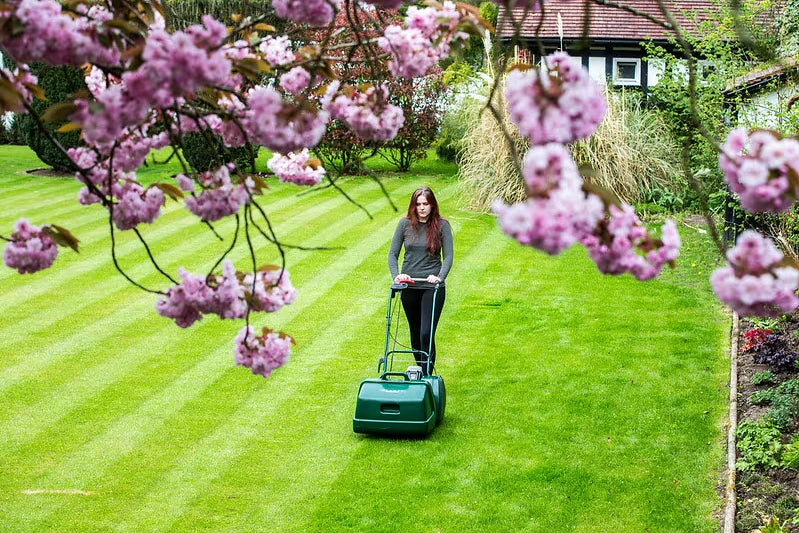
- If the lawn is looking hungry, then I would look to apply fertilisers; again, I would recommend a slow-release fertiliser.
- The lawn and paths will be looking a bit rough around the edges after the winter and will need to be re-established again; use long handled shears and/or cut out with a half-moon spade.
- If you haven’t had your mower serviced yet, please do so as time is running out. Before you know, it will be spring and you may find yourself at the back of a very long queue. Our dealers are beginning to get busy already https://allett.co.uk/pages/global-dealer-locator
March Lawncare Tips
- It's been a very wet January and February. I hope this doesn’t continue into March otherwise we’ll be having a delayed start to the season.
- Firstly, clear any debris that may have occurred after the rains and then lightly aerate the surface of the lawn with a garden fork or machine if you can; this will improve oxygen levels and help rain and any water move off the surface and though the soil profile. These aeration holes are also very useful for re-seeding any areas of the lawn that have either died off or have thinned. Don't reseed until the frosts have gone.
- For a lot of us, the wet January will have caused our lawns to suffer from lack of light and waterlogging which will have encouraged lots of moss growth.
- If moss is showing through the grass then moss control can be achieved with the use of Iron based fertilisers; these feeds can either be soluble or granular types. This will ‘blacken’ the moss initially and then kill it. I would then look to remove the dead moss with a rake or even better your Scarifier cartridge. Make sure there is no frost around before you do this. Don't go on your lawn if it's still wet either as you will churn it up.
- Once the dead moss has been removed, look to reseed any areas that need it and then fertilise the whole lawn- again make sure there are no frosts around. We would recommend using a slow-release fertiliser which, with regular mowing, will help thicken up the lawn again.
- We are bound to get some cold spells before the end of this month. As a result, I would check for frosts before walking over the lawn and examine its overall condition. If it is frosted, please keep off until the frost has lifted.
- Once the frost has lifted, collect any leaf litter or debris littering the garden. If leaf litter is left, it will stop the light and air from getting to the grass underneath, which can cause the grass to rot and leave bare patches.

- If the lawn is looking hungry, then I would look to apply fertilisers; again, I would recommend a slow-release fertiliser.
- The lawn and paths will be looking a bit rough around the edges after the winter and will need to be re-established again; use long handled shears and/or cut out with a half-moon spade.
- If you haven’t had your mower serviced yet, please do so as time is running out. Before you know, it will be spring and you may find yourself at the back of a very long queue. Our dealers are beginning to get busy already https://allett.co.uk/pages/global-dealer-locator
April Lawncare Tips
- Following a dry end to March and more sunshine in the coming few weeks April brings with it a real feeling of spring mainly helped by the changing clocks and longer, lighter nights. A slight increase in temperatures lately has started to take the edge off the cold and we are now seeing soil temperatures start to rise and some essential turf growth and recovery.

- Although never far from the back of my mind is that there has been snow in April in the past so we must not get too carried away; but fingers crossed, not this year! You may need to start watering your lawn soon as this prolonged dry spell goes on- things are really drying out!
- If the winter months have left you with moss, this would be an ideal time to start to do the necessary renovations. Make sure there are no frosts around before you start scarifying though. If you are lucky enough to own an Allett Scarifier cartridge than this will get some usage this month! Make sure you are not stressing it in a dry spell- ensure you are watering deep.
- You could look at applying Iron to kill the moss; this can either be sprayed on or applied as a granular. The moss will ‘blacken’ off and, once it is dead, then it will need to be raked or scarified out. Follow this with some fertiliser to help the grass fill the gaps caused by the removal of the moss.
- If there are any bare or thin patches in the lawn, then those areas will need to be re-seeded. Please ensure that adequate irrigation is applied, as a lack of water is the most common reason that a re-seed fails.
- If the lawn is looking hungry, make an application of a spring/summer fertiliser; I would recommend using a slow-release type as this, alongside regular mowing, allows the sward to thicken out.
- Aerate the lawn by lightly pricking the surface with a garden fork; this will improve oxygen levels and help rain and irrigation to penetrate the surface and more easily reach the grass roots. These aeration holes are also very useful for re-seeding any areas of the lawn that have either died off or have thinned.
- Make sure your mower blades are clean and sharp. Don’t cut the grass short at this stage of the season. Gradually reduce the height of cut to reach your preferred height. The rule of thumb is not to cut off more than a third of the height at any one time. Maintain neat lawn and path edges by trimming back excess grass growth with lawn edging trimmers on a regular basis.
April Lawncare Tips
- Following a dry end to March and more sunshine in the coming few weeks April brings with it a real feeling of spring mainly helped by the changing clocks and longer, lighter nights. A slight increase in temperatures lately has started to take the edge off the cold and we are now seeing soil temperatures start to rise and some essential turf growth and recovery.

- Although never far from the back of my mind is that there has been snow in April in the past so we must not get too carried away; but fingers crossed, not this year! You may need to start watering your lawn soon as this prolonged dry spell goes on- things are really drying out!
- If the winter months have left you with moss, this would be an ideal time to start to do the necessary renovations. Make sure there are no frosts around before you start scarifying though. If you are lucky enough to own an Allett Scarifier cartridge than this will get some usage this month! Make sure you are not stressing it in a dry spell- ensure you are watering deep.
- You could look at applying Iron to kill the moss; this can either be sprayed on or applied as a granular. The moss will ‘blacken’ off and, once it is dead, then it will need to be raked or scarified out. Follow this with some fertiliser to help the grass fill the gaps caused by the removal of the moss.
- If there are any bare or thin patches in the lawn, then those areas will need to be re-seeded. Please ensure that adequate irrigation is applied, as a lack of water is the most common reason that a re-seed fails.
- If the lawn is looking hungry, make an application of a spring/summer fertiliser; I would recommend using a slow-release type as this, alongside regular mowing, allows the sward to thicken out.
- Aerate the lawn by lightly pricking the surface with a garden fork; this will improve oxygen levels and help rain and irrigation to penetrate the surface and more easily reach the grass roots. These aeration holes are also very useful for re-seeding any areas of the lawn that have either died off or have thinned.
- Make sure your mower blades are clean and sharp. Don’t cut the grass short at this stage of the season. Gradually reduce the height of cut to reach your preferred height. The rule of thumb is not to cut off more than a third of the height at any one time. Maintain neat lawn and path edges by trimming back excess grass growth with lawn edging trimmers on a regular basis.
May Lawncare Tips
- May is a fantastic time to give your lawn the care it needs to flourish throughout the summer months. As temperatures begin to rise, the grass will start growing at a faster rate, and with the right maintenance, your lawn can look beautifully healthy.
- It would make sense to take advantage of the wet weather to fertilise the lawn, and give it chance to recover from any wear and tear or spring renovations that may have been done earlier.
- If you do fertilise your lawn, try using a slow-release fertiliser that will help keep the lawn green longer without too much top growth.
- You should be mowing at least once per week ideally twice as we move into the peak growing period. Little and often is the key. Make sure you are not cutting off more than a third of the grass plant height at any one time
- Don’t forget to trim the lawn edges, as and when required, with edging shears to keep them looking neat and tidy.
- Look to pull up isolated weeds or carry out spot treatment with a proprietary lawn weed killer Note: make sure the weed killer is suitable for grass, otherwise, you will kill the grass as well as the weeds.
- If you still have any moss in the lawn, it can be controlled with the use of Iron Sulphate, either in a liquid or granular form. This will turn the moss black, and then it should start to die off not long after. Afterwards, lightly scarify to remove the dead moss and allow the grass the chance to recolonise the mossed areas. You should be scarifying with your spring rake cartridge AT LEAST once a month.
- Please keep an eye on any seedlings and be prepared to water if we don’t get rain for a while. It doesn’t make sense to do all that work and then let the seed die.
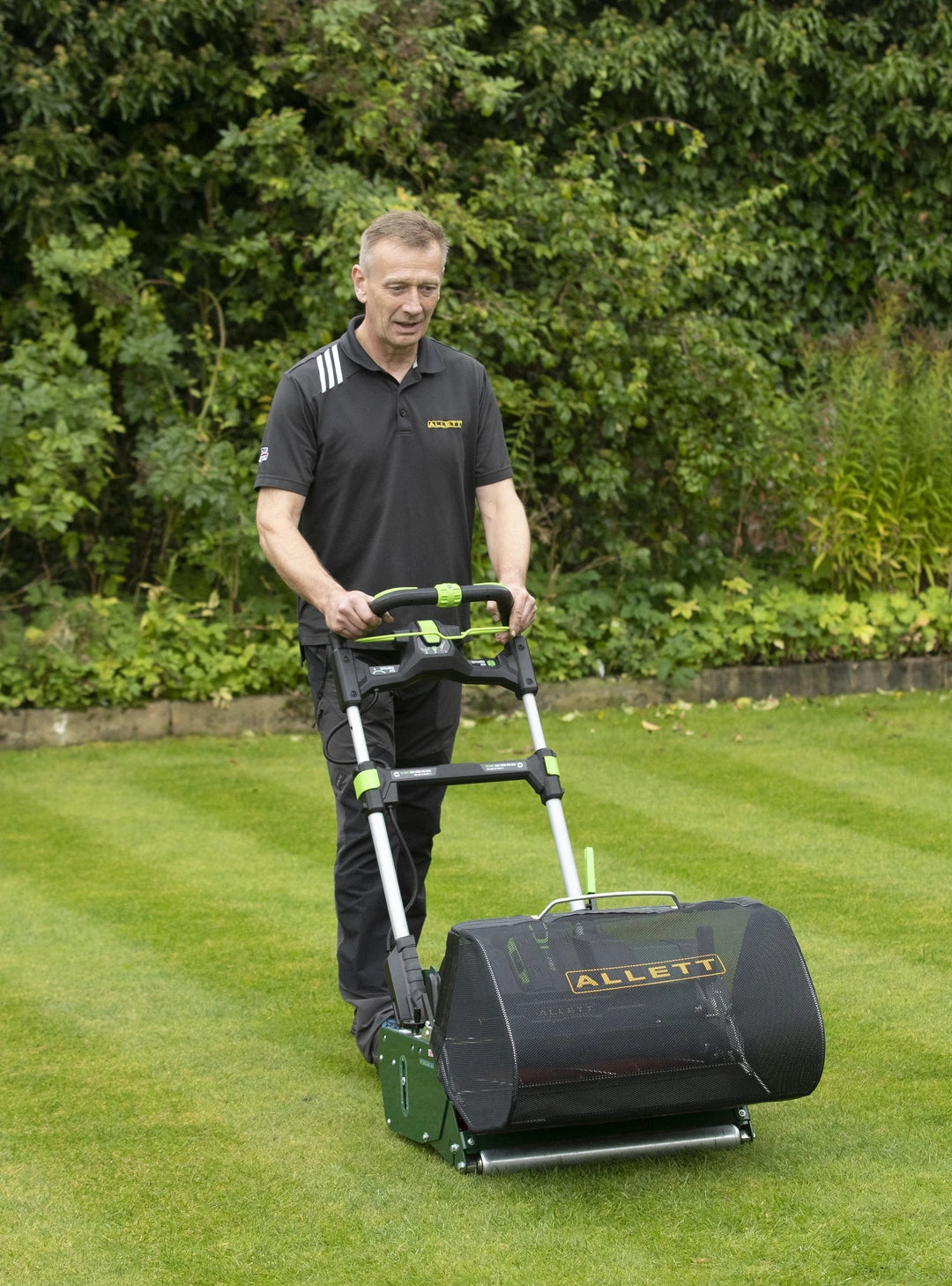
May Lawncare Tips
- May is a fantastic time to give your lawn the care it needs to flourish throughout the summer months. As temperatures begin to rise, the grass will start growing at a faster rate, and with the right maintenance, your lawn can look beautifully healthy.
- It would make sense to take advantage of the wet weather to fertilise the lawn, and give it chance to recover from any wear and tear or spring renovations that may have been done earlier.
- If you do fertilise your lawn, try using a slow-release fertiliser that will help keep the lawn green longer without too much top growth.
- You should be mowing at least once per week ideally twice as we move into the peak growing period. Little and often is the key. Make sure you are not cutting off more than a third of the grass plant height at any one time
- Don’t forget to trim the lawn edges, as and when required, with edging shears to keep them looking neat and tidy.
- Look to pull up isolated weeds or carry out spot treatment with a proprietary lawn weed killer Note: make sure the weed killer is suitable for grass, otherwise, you will kill the grass as well as the weeds.
- If you still have any moss in the lawn, it can be controlled with the use of Iron Sulphate, either in a liquid or granular form. This will turn the moss black, and then it should start to die off not long after. Afterwards, lightly scarify to remove the dead moss and allow the grass the chance to recolonise the mossed areas. You should be scarifying with your spring rake cartridge AT LEAST once a month.
- Please keep an eye on any seedlings and be prepared to water if we don’t get rain for a while. It doesn’t make sense to do all that work and then let the seed die.

June Lawncare Tips
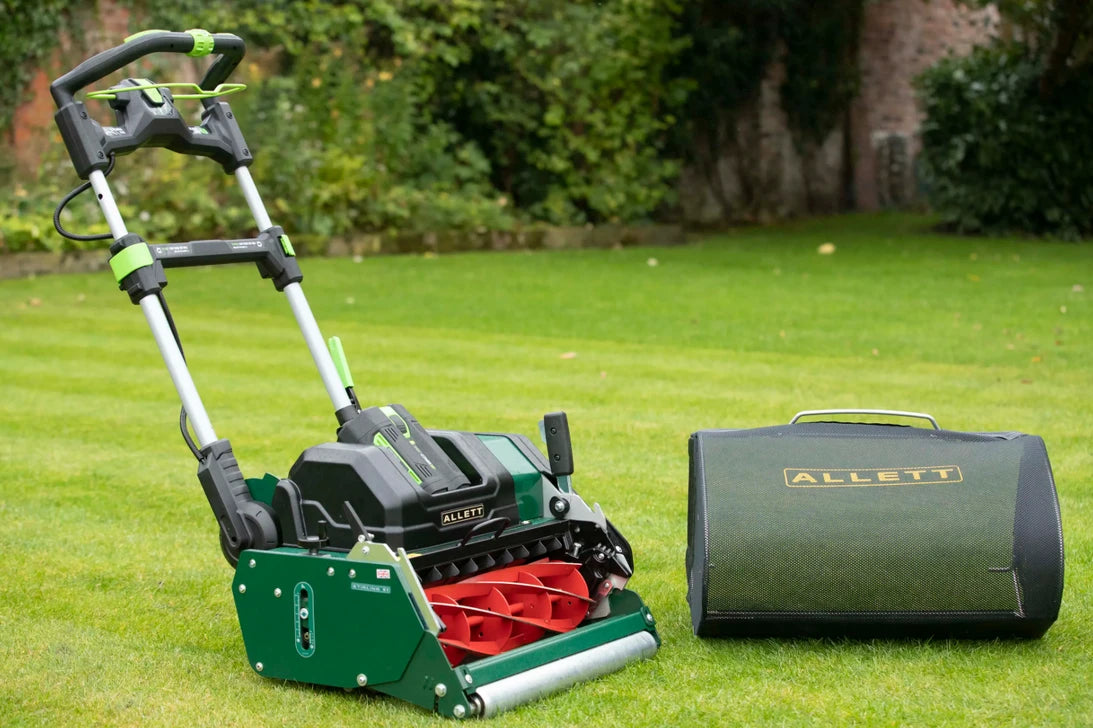
- We have had some better growing conditions recently with a bit of sunshine, mild temperatures and also a lot of rain around so hopefully your grass is looking good. Your lawn needs 25mm a week to survive or approx 3mm-4mm a day so bare this in mind if we have a dry spell... IF!
- To maintain a high standard please mow on a more regular basis, at least twice per week. The height of cut should now be at the summer height of cut between 15-20mm.
- We would recommend applying a slow release fertiliser at this time of year. This allows the lawn to maintain its colour while encouraging a manageable amount of growth.
- As previously mentioned, the height of cut should be between 15 - 20mm. Lawns that are uniformly level and thatch free can be mowed at a height less than 15mm.
- Continue to trim lawn edges as and when required with edging shears (or even better an edger) to keep them looking neat and tidy.
- Continue to pull up isolated weeds or carry out spot treatment with a proprietary lawn weed killer Note: make sure the weed killer is suitable for grass, otherwise you will kill the grass as well as the weeds.
- Check the mower blades are still sharp and that all moving parts are lubricated as per the manufacturer’s guidelines.• Continue to lightly scarify the lawn with our spring tined rake Scarifier to remove thatch (the build-up of excess organic matter on the surface of the soil). This is necessary as thatch will hold water on the surface like a sponge encouraging the grass to grow shallow roots which will make the plant less tolerant of dry weather as it does not have roots extending deep down into the soil to find moisture. Thatch can also harbour turf diseases.Verticut regularly to help get rid of lateral growth. This will help thicken your lawn by cutting rhizomes and stolon
June Lawncare Tips

- We have had some better growing conditions recently with a bit of sunshine, mild temperatures and also a lot of rain around so hopefully your grass is looking good. Your lawn needs 25mm a week to survive or approx 3mm-4mm a day so bare this in mind if we have a dry spell... IF!
- To maintain a high standard please mow on a more regular basis, at least twice per week. The height of cut should now be at the summer height of cut between 15-20mm.
- We would recommend applying a slow release fertiliser at this time of year. This allows the lawn to maintain its colour while encouraging a manageable amount of growth.
- As previously mentioned, the height of cut should be between 15 - 20mm. Lawns that are uniformly level and thatch free can be mowed at a height less than 15mm.
- Continue to trim lawn edges as and when required with edging shears (or even better an edger) to keep them looking neat and tidy.
- Continue to pull up isolated weeds or carry out spot treatment with a proprietary lawn weed killer Note: make sure the weed killer is suitable for grass, otherwise you will kill the grass as well as the weeds.
- Check the mower blades are still sharp and that all moving parts are lubricated as per the manufacturer’s guidelines.• Continue to lightly scarify the lawn with our spring tined rake Scarifier to remove thatch (the build-up of excess organic matter on the surface of the soil). This is necessary as thatch will hold water on the surface like a sponge encouraging the grass to grow shallow roots which will make the plant less tolerant of dry weather as it does not have roots extending deep down into the soil to find moisture. Thatch can also harbour turf diseases.Verticut regularly to help get rid of lateral growth. This will help thicken your lawn by cutting rhizomes and stolon
July Lawncare Tips
- With the recent drier and warmer weather our lawns will be getting a bit drier. As the grass is in the process of recovering from the hotter weather experienced in June you will need to be watering more often (click here)
- To aid the grass in its recovery it is advisable to apply a light feed using a slow-release fertiliser. This will help maintain the lawn's green appearance without excessive top growth. It is recommended to carry out this fertilisation just before the arrival of rain allowing the water to wash the fertiliser into the soil. However, it's important to avoid applying the fertiliser during high heat, as this could potentially scorch the grass.
- If you are considering aerating the lawn lightly prick the surface with a garden fork. This process will enhance oxygen levels and facilitate the penetration of rainwater or irrigation into the soil reaching the grass roots more effectively. Once again, it is best to perform this aeration before rainfall occurs.
- To eliminate thatch, which refers to the accumulation of excess organic matter on the soil surface, lightly scarify the lawn using a spring tined rake. Thatch acts as a sponge holding water on the surface and preventing it from reaching the soil where it is needed. This situation makes the grass less tolerant of dry weather since the roots struggle to find moisture. Additionally, thatch can harbour diseases such as Fusarium.
- Continue to trim the edges of the lawn as necessary. Maintain the mowing height between 15-20mm. Currently there appears to be a prevalence of red thread, a fungal disease that turns the grass a reddish/pink colour. This issue can be resolved by feeding the grass with fertilisers or using chemical fungicides.
- Isolated weeds should be promptly pulled up or spot treatments can be applied using a lawn weed killer product. You can verticut the troublesome areas so help give the weeds a hard time. The healthier your grass is the less chance there is for weeds to take over. Ensure that your mower blades are still sharp and that all moving parts are properly lubricated according to the manufacturer's guidelines. This will enable the mower to cut the grass without putting excessive strain on the machine or tearing the grass which could potentially lead to the onset of diseases.
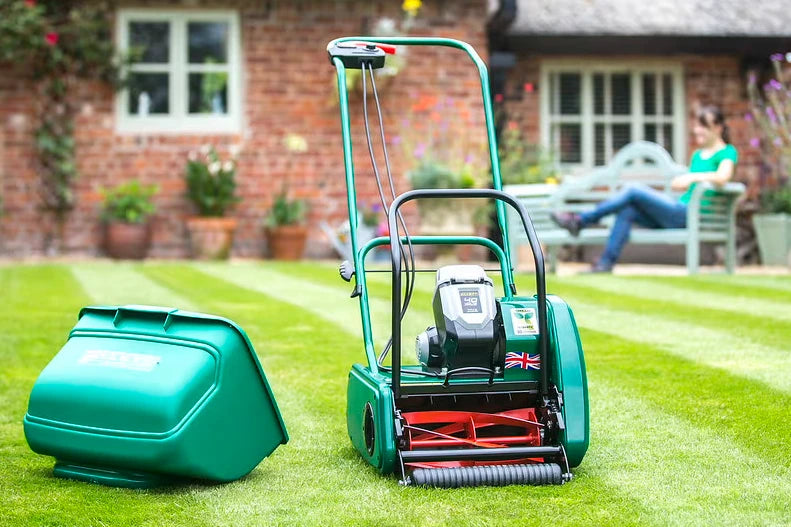
July Lawncare Tips
- With the recent drier and warmer weather our lawns will be getting a bit drier. As the grass is in the process of recovering from the hotter weather experienced in June you will need to be watering more often (click here)
- To aid the grass in its recovery it is advisable to apply a light feed using a slow-release fertiliser. This will help maintain the lawn's green appearance without excessive top growth. It is recommended to carry out this fertilisation just before the arrival of rain allowing the water to wash the fertiliser into the soil. However, it's important to avoid applying the fertiliser during high heat, as this could potentially scorch the grass.
- If you are considering aerating the lawn lightly prick the surface with a garden fork. This process will enhance oxygen levels and facilitate the penetration of rainwater or irrigation into the soil reaching the grass roots more effectively. Once again, it is best to perform this aeration before rainfall occurs.
- To eliminate thatch, which refers to the accumulation of excess organic matter on the soil surface, lightly scarify the lawn using a spring tined rake. Thatch acts as a sponge holding water on the surface and preventing it from reaching the soil where it is needed. This situation makes the grass less tolerant of dry weather since the roots struggle to find moisture. Additionally, thatch can harbour diseases such as Fusarium.
- Continue to trim the edges of the lawn as necessary. Maintain the mowing height between 15-20mm. Currently there appears to be a prevalence of red thread, a fungal disease that turns the grass a reddish/pink colour. This issue can be resolved by feeding the grass with fertilisers or using chemical fungicides.
- Isolated weeds should be promptly pulled up or spot treatments can be applied using a lawn weed killer product. You can verticut the troublesome areas so help give the weeds a hard time. The healthier your grass is the less chance there is for weeds to take over. Ensure that your mower blades are still sharp and that all moving parts are properly lubricated according to the manufacturer's guidelines. This will enable the mower to cut the grass without putting excessive strain on the machine or tearing the grass which could potentially lead to the onset of diseases.

August Lawncare Tips
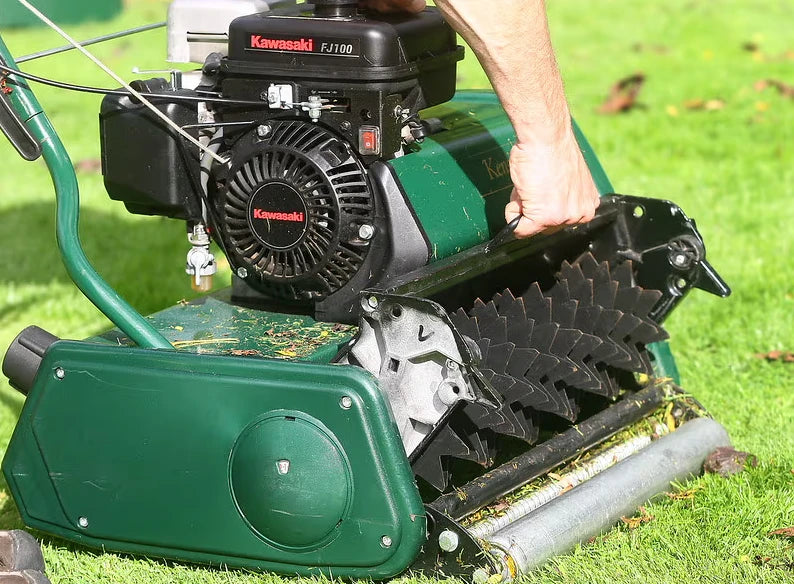
July has witnessed a decent amount of rainfall with lawns managed to stay green, an unusual occurrence during this season. In times of drought it's wise to ensure that you water your lawn thoroughly either in the early morning or late evening to minimise water loss due to evaporation. Opt for deep and infrequent watering instead of shallow and frequent sessions to promote the development of deep roots.
It's essential to keep a vigilant watch on the edges of your lawn, trimming them as required and mowing the lawn if the need arises. Maintaining a healthy lawn involves addressing isolated weed issues by either uprooting them manually or using verticutting techniques to make their survival challenging. As August approaches, it presents an ideal opportunity to aerate your lawn, thereby enhancing both air circulation and water absorption.Employ a garden fork or a mechanical aerator to create perforations in the soil, facilitating better penetration of nutrients and moisture.
Regularly inspect the mower blades to ensure their sharpness, and in accordance with our guidelines, lubricate all movable components. To prevent damage to the lawn, maintain a mowing height ranging from 20mm to 25mm, thus avoiding scalping. Ongoing monthly maintenance tasks such as scarifying and verticutting should persist, but exercise caution to ensure the lawn has sufficient moisture to recover from these procedures. Employ the scarifier and verticut cartridge every fortnight to effectively manage thatch buildup and lateral growth. Given the recent heavy rainfall, a dense thatch layer could result in water accumulation on the surface.Address any bare patches or areas with weakened grass by considering overseeding to bridge the gaps and rejuvenate your lawn, leveraging the favourable growth conditions at hand. It's crucial to note that the current focal point of concern is red thread; for further insights, refer to our corresponding blog.
August Lawncare Tips

July has witnessed a decent amount of rainfall with lawns managed to stay green, an unusual occurrence during this season. In times of drought it's wise to ensure that you water your lawn thoroughly either in the early morning or late evening to minimise water loss due to evaporation. Opt for deep and infrequent watering instead of shallow and frequent sessions to promote the development of deep roots.
It's essential to keep a vigilant watch on the edges of your lawn, trimming them as required and mowing the lawn if the need arises. Maintaining a healthy lawn involves addressing isolated weed issues by either uprooting them manually or using verticutting techniques to make their survival challenging. As August approaches, it presents an ideal opportunity to aerate your lawn, thereby enhancing both air circulation and water absorption.Employ a garden fork or a mechanical aerator to create perforations in the soil, facilitating better penetration of nutrients and moisture.
Regularly inspect the mower blades to ensure their sharpness, and in accordance with our guidelines, lubricate all movable components. To prevent damage to the lawn, maintain a mowing height ranging from 20mm to 25mm, thus avoiding scalping. Ongoing monthly maintenance tasks such as scarifying and verticutting should persist, but exercise caution to ensure the lawn has sufficient moisture to recover from these procedures. Employ the scarifier and verticut cartridge every fortnight to effectively manage thatch buildup and lateral growth. Given the recent heavy rainfall, a dense thatch layer could result in water accumulation on the surface.Address any bare patches or areas with weakened grass by considering overseeding to bridge the gaps and rejuvenate your lawn, leveraging the favourable growth conditions at hand. It's crucial to note that the current focal point of concern is red thread; for further insights, refer to our corresponding blog.
September Lawncare Tips
September is the month of renovations. You might not be ready to do this yet and want to enjoy more of your lawn before the season ends so there is no rush. You just need a period of around 5-6 weeks ahead of frosts. If you are not ready than a light scarification would be good but you do need to think about doing it before November.
The recommended course of action for a full renovation entails:
- Scarification: This process involves removing dead grass and accumulated thatch (excessive organic matter on the soil's surface). The dead grass and thatch act like a sponge fostering the growth of moss and inhibiting the development of deep-rooted grass. Consequently, the grass becomes less resilient to future dry spells as its roots struggle to access moisture beneath the surface. Thatch can also harbour turf diseases like Fusarium and serve as a breeding ground for moss.
- Aeration: Whether using solid or hollow tines, aerating the lawn reduces surface compaction, facilitating the movement of both air and water through the top layer of turf. This aids in water movement within the soil preventing moss growth and promoting root expansion in the lawn. In the case of hollow tining, the removed cores can either be discarded or repurposed as a dressing for the next spring or autumn.
- Reseeding: Target areas with bare patches as well as thin or uneven grass coverage. Reseeding will not only thicken the lawn but also introduce more robust grass varieties helping to suppress weed growth and moss proliferation.
- Topdressing: Utilise a soil/sand blend to cover the newly applied seeds and level out any depressions or hollows on the lawn's surface. After application use the back of a garden rake or the Allett Lawn Lute to smooth the dressing. It's important not to attempt to "bury" the grass; ensure that it remains visible through the topdressing to prevent smothering and potential death of the grass beneath.
- Fertilising: Apply an autumn/winter fertiliser that contains lower levels of Nitrogen and higher amounts of Phosphate and Potash compared to summer feeds. Phosphate and Potash contribute to root growth and fortify the plant's cell structure, enhancing its resilience and health as it enters the winter season. Opt for a slow-release fertiliser to gradually provide nutrients to the lawn without inducing rapid growth.
- Adjust Mowing Height: After the renovations, raise the mowing height to 30-40mm. You won't need to mow for a fair few weeks until the seed is established.
- Edge Trimming:Neat Edges: Maintain a tidy lawn by trimming the edges. This not only looks good but also helps prevent the lawn from creeping into flower beds.
- Note: Given the time of year, there's often talk of heatwaves and Indian Summers which might materialise unexpectedly. Before initiating renovations, monitor weather forecasts diligently as prolonged dry periods following renovations could have adverse effects. Be prepared to irrigate if necessary.
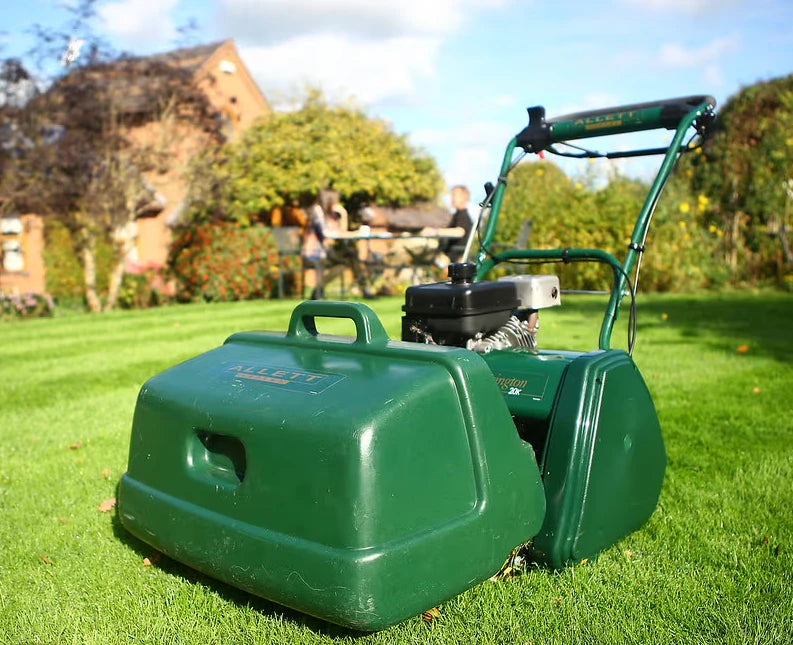
September Lawncare Tips
September is the month of renovations. You might not be ready to do this yet and want to enjoy more of your lawn before the season ends so there is no rush. You just need a period of around 5-6 weeks ahead of frosts. If you are not ready than a light scarification would be good but you do need to think about doing it before November.
The recommended course of action for a full renovation entails:
- Scarification: This process involves removing dead grass and accumulated thatch (excessive organic matter on the soil's surface). The dead grass and thatch act like a sponge fostering the growth of moss and inhibiting the development of deep-rooted grass. Consequently, the grass becomes less resilient to future dry spells as its roots struggle to access moisture beneath the surface. Thatch can also harbour turf diseases like Fusarium and serve as a breeding ground for moss.
- Aeration: Whether using solid or hollow tines, aerating the lawn reduces surface compaction, facilitating the movement of both air and water through the top layer of turf. This aids in water movement within the soil preventing moss growth and promoting root expansion in the lawn. In the case of hollow tining, the removed cores can either be discarded or repurposed as a dressing for the next spring or autumn.
- Reseeding: Target areas with bare patches as well as thin or uneven grass coverage. Reseeding will not only thicken the lawn but also introduce more robust grass varieties helping to suppress weed growth and moss proliferation.
- Topdressing: Utilise a soil/sand blend to cover the newly applied seeds and level out any depressions or hollows on the lawn's surface. After application use the back of a garden rake or the Allett Lawn Lute to smooth the dressing. It's important not to attempt to "bury" the grass; ensure that it remains visible through the topdressing to prevent smothering and potential death of the grass beneath.
- Fertilising: Apply an autumn/winter fertiliser that contains lower levels of Nitrogen and higher amounts of Phosphate and Potash compared to summer feeds. Phosphate and Potash contribute to root growth and fortify the plant's cell structure, enhancing its resilience and health as it enters the winter season. Opt for a slow-release fertiliser to gradually provide nutrients to the lawn without inducing rapid growth.
- Adjust Mowing Height: After the renovations, raise the mowing height to 30-40mm. You won't need to mow for a fair few weeks until the seed is established.
- Edge Trimming:Neat Edges: Maintain a tidy lawn by trimming the edges. This not only looks good but also helps prevent the lawn from creeping into flower beds.
- Note: Given the time of year, there's often talk of heatwaves and Indian Summers which might materialise unexpectedly. Before initiating renovations, monitor weather forecasts diligently as prolonged dry periods following renovations could have adverse effects. Be prepared to irrigate if necessary.

October Lawncare Tips
- The weather definitely has an autumnal feel to it now with cool mornings and heavy dews. And as those day and night time temperatures fall, so will the soil temperatures; so if you haven’t started your autumn renovations, I would before it’s too late. The milder temperatures will help with germination.
- Scarification is necessary as thatch (the build-up of excess organic matter on the surface of the soil) will hold water on the surface like a sponge, encouraging the proliferation of moss and reducing the need for the grass to develop a deep root base. This makes the grass plant less tolerant of dry weather as the roots cannot find moisture. Thatch can also harbour turf diseases such Fusarium.
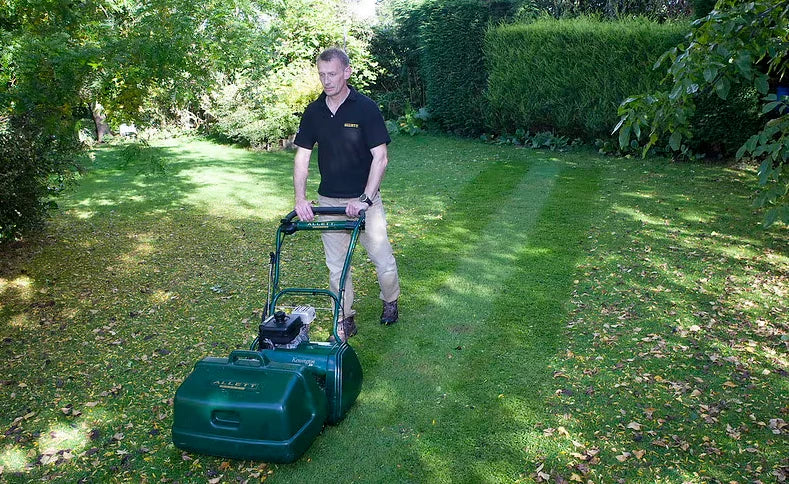
- Aerate the lawn with either solid or hollow tines. The alleviation of compaction in the surface will allow the movement of both air and water though the top layer of the turf. This helps with drainage and therefore helping to prevent moss, and also encourages root development. When hollow tining, the cores will have to be removed; these can either be disposed of or recycled as a dressing for the spring or next autumn.
- Re-seed the lawn, not only where the grass is thin or patchy, but also as a way of adding newer more vigorous grasses into the sward.
- Top dress the lawn with a soil/sand mix to cover the recently applied seed and to remove dips and hollows from the lawn. Once applied, use the back of a garden rake to level off the dressing. Do not bury the grass, always ensure that it is showing through the top dressing otherwise you can ‘suffocate’ and kill the grass beneath it
- Raise the height of cut after renovations to 30-40mm; any lower and you encourage the build-up of moss within the lawn. The less light that can get to base of the sward the less moss spores that are able to germinate.
- Fertilise the lawn with an autumn/winter fertiliser; these are usually low in Nitrogen but have a higher amount of Phosphate and Potash than summer feeds. These latter two nutrients help with root development and strengthen the plant cell walls, therefore allowing the turf to go into winter stronger and healthier. It would be a good idea to apply iron to your lawn to help it get through the winter.
- This is also the time that trees shed their leaves, so leaf collection should be done at regular intervals. If leaf litter is left on the lawn it can kill the grass beneath it. You can use your scarifier or brush cartridge to pick up leaves.
- Continue to trim lawn edges as and when required to keep them looking neat and tidy.
October Lawncare Tips
- The weather definitely has an autumnal feel to it now with cool mornings and heavy dews. And as those day and night time temperatures fall, so will the soil temperatures; so if you haven’t started your autumn renovations, I would before it’s too late. The milder temperatures will help with germination.
- Scarification is necessary as thatch (the build-up of excess organic matter on the surface of the soil) will hold water on the surface like a sponge, encouraging the proliferation of moss and reducing the need for the grass to develop a deep root base. This makes the grass plant less tolerant of dry weather as the roots cannot find moisture. Thatch can also harbour turf diseases such Fusarium.

- Aerate the lawn with either solid or hollow tines. The alleviation of compaction in the surface will allow the movement of both air and water though the top layer of the turf. This helps with drainage and therefore helping to prevent moss, and also encourages root development. When hollow tining, the cores will have to be removed; these can either be disposed of or recycled as a dressing for the spring or next autumn.
- Re-seed the lawn, not only where the grass is thin or patchy, but also as a way of adding newer more vigorous grasses into the sward.
- Top dress the lawn with a soil/sand mix to cover the recently applied seed and to remove dips and hollows from the lawn. Once applied, use the back of a garden rake to level off the dressing. Do not bury the grass, always ensure that it is showing through the top dressing otherwise you can ‘suffocate’ and kill the grass beneath it
- Raise the height of cut after renovations to 30-40mm; any lower and you encourage the build-up of moss within the lawn. The less light that can get to base of the sward the less moss spores that are able to germinate.
- Fertilise the lawn with an autumn/winter fertiliser; these are usually low in Nitrogen but have a higher amount of Phosphate and Potash than summer feeds. These latter two nutrients help with root development and strengthen the plant cell walls, therefore allowing the turf to go into winter stronger and healthier. It would be a good idea to apply iron to your lawn to help it get through the winter.
- This is also the time that trees shed their leaves, so leaf collection should be done at regular intervals. If leaf litter is left on the lawn it can kill the grass beneath it. You can use your scarifier or brush cartridge to pick up leaves.
- Continue to trim lawn edges as and when required to keep them looking neat and tidy.
November Lawncare Tips
- After a mild and wet October some of your lawns will be rather wet! Regularly aerating your lawn would be a good idea. To improve drainage, spike the lawn with a garden fork or mechanical aerator.
- Most of the leaves have yet to fall, though once we have a frost this should accelerate the process; it’s important that you collect these regularly, especially if you reseeded this autumn. If leaves are left, they will smother the new grass leaving dead patches that moss will colonise, and you’ll be back to square one. Use your scarifier or brush cartridge in your Allett mower to pick these up.
- Your autumn renovations should now have been completed and the lawn can be left to regenerate at its own pace. The recent mild weather and rain should have helped with this however some of your may not have been able to do this with the heavy rainfall. If you haven't renovated yet be aware of frosts as you don't want cold weather if you are seeding.
- If you need to fertilise the lawn, please use an autumn/winter fertiliser; these are usually low in Nitrogen but have a higher amount of Phosphate and Potash than summer feeds. These two last nutrients help with root development and strengthen the plant’s cell walls, therefore allowing the turf to go into winter with stronger and healthier plants. N.B a slow-release fertiliser would be better, as this will slowly introduce the nutrients into the ground over the 3 months or so of its life rather than a sudden flush of growth which could encourage lawn diseases such as Fusarium.
- Also, fertilisers with high iron content can also be used to harden the grass and help prevent moss. N.B Please ensure when using these types of fertilisers that any granules that come into contact with stone or light paving are brushed off as soon as possible as the iron can stain, leaving it covered with pink/orange dots.
- If you do need to cut the grass, please raise your mower’s height of cut so it is between 30-40mm; any lower and you encourage the build-up of moss within the lawn.
- Continue to trim lawn edges, if you already haven’t done so, with edging shears to keep them looking neat and tidy.
- Also prune back any herbaceous plants that are over hanging the lawn or which may do so once the growing season starts again in the new year. These obscure the light to the lawn creating unsightly bald patches and can encourage moss or weeds.
- If the grass has a frost, I recommend that you wait until it lifts before going onto the grass as the foot fall can damage the grass, leaving ‘black’ footprints within the sward.
- Algae can appear on lawns with poor drainage or excessive shade, or under the drip-line of trees. Yellow or brown patches at this time of year may be caused by the fungal disease fusarium patch, especially in wet weather and in overfed, lush lawns that have been left a bit too long.
- Worm casts are a sign of healthy soil, but if you don’t like them on your lawn, brush them off with a hard broom or use your brush cartridge with the auxiliary wheels on in place of the front roller.
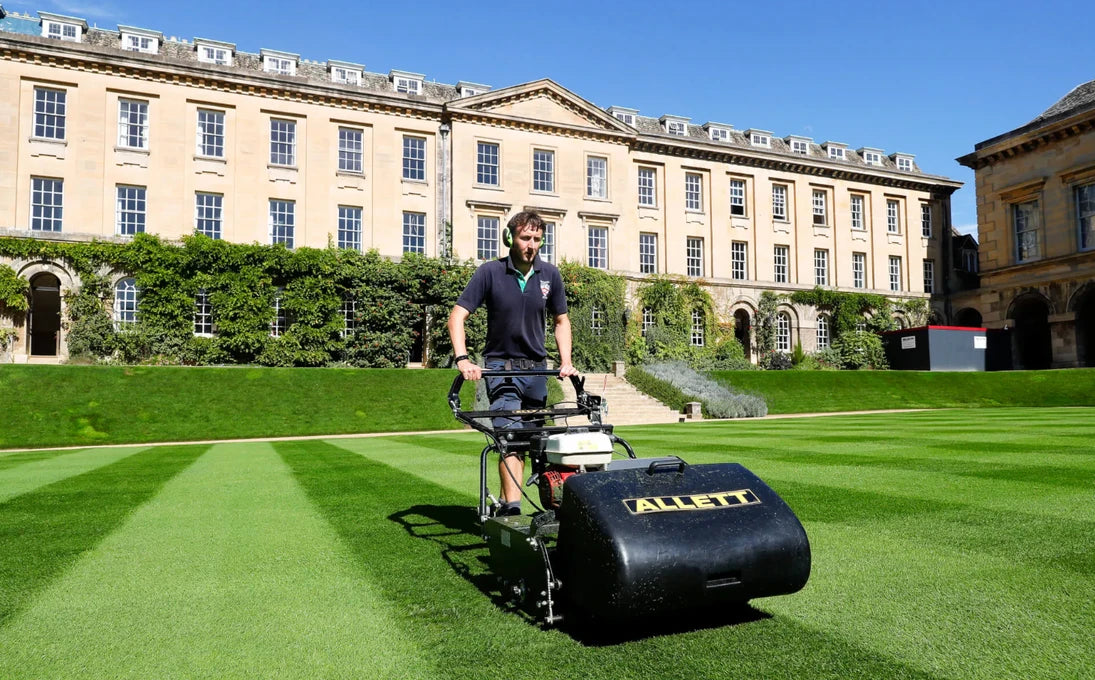
November Lawncare Tips
- After a mild and wet October some of your lawns will be rather wet! Regularly aerating your lawn would be a good idea. To improve drainage, spike the lawn with a garden fork or mechanical aerator.
- Most of the leaves have yet to fall, though once we have a frost this should accelerate the process; it’s important that you collect these regularly, especially if you reseeded this autumn. If leaves are left, they will smother the new grass leaving dead patches that moss will colonise, and you’ll be back to square one. Use your scarifier or brush cartridge in your Allett mower to pick these up.
- Your autumn renovations should now have been completed and the lawn can be left to regenerate at its own pace. The recent mild weather and rain should have helped with this however some of your may not have been able to do this with the heavy rainfall. If you haven't renovated yet be aware of frosts as you don't want cold weather if you are seeding.
- If you need to fertilise the lawn, please use an autumn/winter fertiliser; these are usually low in Nitrogen but have a higher amount of Phosphate and Potash than summer feeds. These two last nutrients help with root development and strengthen the plant’s cell walls, therefore allowing the turf to go into winter with stronger and healthier plants. N.B a slow-release fertiliser would be better, as this will slowly introduce the nutrients into the ground over the 3 months or so of its life rather than a sudden flush of growth which could encourage lawn diseases such as Fusarium.
- Also, fertilisers with high iron content can also be used to harden the grass and help prevent moss. N.B Please ensure when using these types of fertilisers that any granules that come into contact with stone or light paving are brushed off as soon as possible as the iron can stain, leaving it covered with pink/orange dots.
- If you do need to cut the grass, please raise your mower’s height of cut so it is between 30-40mm; any lower and you encourage the build-up of moss within the lawn.
- Continue to trim lawn edges, if you already haven’t done so, with edging shears to keep them looking neat and tidy.
- Also prune back any herbaceous plants that are over hanging the lawn or which may do so once the growing season starts again in the new year. These obscure the light to the lawn creating unsightly bald patches and can encourage moss or weeds.
- If the grass has a frost, I recommend that you wait until it lifts before going onto the grass as the foot fall can damage the grass, leaving ‘black’ footprints within the sward.
- Algae can appear on lawns with poor drainage or excessive shade, or under the drip-line of trees. Yellow or brown patches at this time of year may be caused by the fungal disease fusarium patch, especially in wet weather and in overfed, lush lawns that have been left a bit too long.
- Worm casts are a sign of healthy soil, but if you don’t like them on your lawn, brush them off with a hard broom or use your brush cartridge with the auxiliary wheels on in place of the front roller.

December Lawncare Tips
As we move into December after a period of mild and wet weather colder temperatures and frosts are expected- we have already had our first snowfall. For those with finely manicured lawns it’s important to avoid walking on the grass until the frost has lifted. Walking on frosty grass can cause bruising and leave black footprints which will turn brown as the grass dies.
- Leaf Removal: Raking up fallen leaves promptly is essential to maintaining a healthy lawn. Left unchecked leaves can block sunlight leading to bare patches and encouraging weeds or moss. Additionally, accumulating leaf litter can attract worms to the surface which while beneficial for the lawn’s biological health can create unsightly worm casts and contribute to weed growth come spring. If the weather allows consider using a scarifier or a mower with a brush cartridge to help clear the lawn
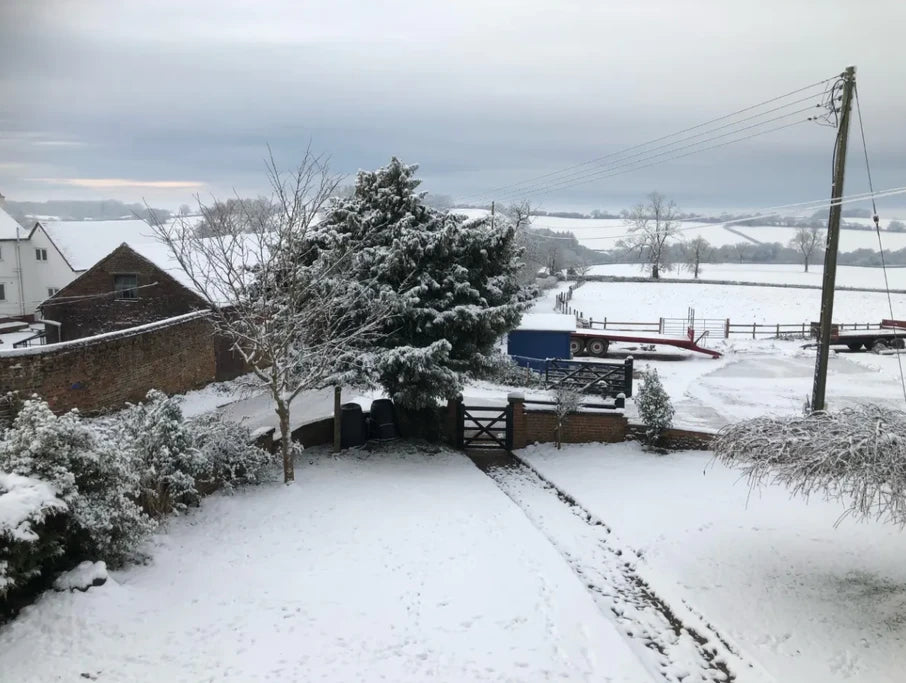
- Fertilising Your Lawn: If you haven’t already applied autumn/winter fertiliser to your lawn now is the time. These fertilisers are specially formulated with lower nitrogen and higher phosphate and potash levels promoting strong root development and fortifying the grass to endure the winter months. A slow-release fertiliser is preferable as it ensures a steady release of nutrients over time reducing the risk of lawn diseases like Fusarium. Fertilisers with high iron content can also help to toughen the grass and combat moss growth. However, be cautious of potential staining on stone or light paving surfaces.
- Trim Overhanging Plants: Now is a good time to trim back any herbaceous plants that are overhanging the lawn or may do so in the coming months. This ensures that the lawn receives adequate sunlight, helping to prevent bald patches and discouraging the growth of moss or weeds.
- Mower Maintenance: With many mowers being stored for the winter it’s easy to forget about their upkeep. However it's important to clean and lubricate the working parts especially if you have a petrol mower. Remove any remaining petrol to avoid it going stale and potentially hindering the mower’s start in the New Year. For battery mowers store the battery in a cool, dry place and keep the mower elevated and covered to protect it from moisture. When cleaning, avoid using water on electric mowers as this can cause damage. Instead, use a soft cloth or brush. If you use water on the cylinder ensure it is thoroughly dried afterward to prevent rust and consider applying WD40 to the blade.
- If possible arrange for an annual service with your local Allett Dealer before spring arrives- don't leave it until Spring or you could be at the end of a long queue!
- Wishing You a Merry Christmas and a Happy New YearWe hope you enjoy a peaceful holiday season and that your lawn is ready for the year ahead! Don’t forget to book your annual mower service with your nearest dealer. Find your local dealerhere.
December Lawncare Tips
As we move into December after a period of mild and wet weather colder temperatures and frosts are expected- we have already had our first snowfall. For those with finely manicured lawns it’s important to avoid walking on the grass until the frost has lifted. Walking on frosty grass can cause bruising and leave black footprints which will turn brown as the grass dies.
- Leaf Removal: Raking up fallen leaves promptly is essential to maintaining a healthy lawn. Left unchecked leaves can block sunlight leading to bare patches and encouraging weeds or moss. Additionally, accumulating leaf litter can attract worms to the surface which while beneficial for the lawn’s biological health can create unsightly worm casts and contribute to weed growth come spring. If the weather allows consider using a scarifier or a mower with a brush cartridge to help clear the lawn

- Fertilising Your Lawn: If you haven’t already applied autumn/winter fertiliser to your lawn now is the time. These fertilisers are specially formulated with lower nitrogen and higher phosphate and potash levels promoting strong root development and fortifying the grass to endure the winter months. A slow-release fertiliser is preferable as it ensures a steady release of nutrients over time reducing the risk of lawn diseases like Fusarium. Fertilisers with high iron content can also help to toughen the grass and combat moss growth. However, be cautious of potential staining on stone or light paving surfaces.
- Trim Overhanging Plants: Now is a good time to trim back any herbaceous plants that are overhanging the lawn or may do so in the coming months. This ensures that the lawn receives adequate sunlight, helping to prevent bald patches and discouraging the growth of moss or weeds.
- Mower Maintenance: With many mowers being stored for the winter it’s easy to forget about their upkeep. However it's important to clean and lubricate the working parts especially if you have a petrol mower. Remove any remaining petrol to avoid it going stale and potentially hindering the mower’s start in the New Year. For battery mowers store the battery in a cool, dry place and keep the mower elevated and covered to protect it from moisture. When cleaning, avoid using water on electric mowers as this can cause damage. Instead, use a soft cloth or brush. If you use water on the cylinder ensure it is thoroughly dried afterward to prevent rust and consider applying WD40 to the blade.
- If possible arrange for an annual service with your local Allett Dealer before spring arrives- don't leave it until Spring or you could be at the end of a long queue!
- Wishing You a Merry Christmas and a Happy New YearWe hope you enjoy a peaceful holiday season and that your lawn is ready for the year ahead! Don’t forget to book your annual mower service with your nearest dealer. Find your local dealerhere.

